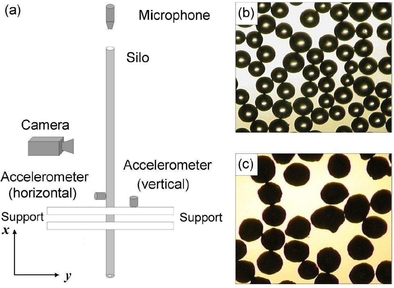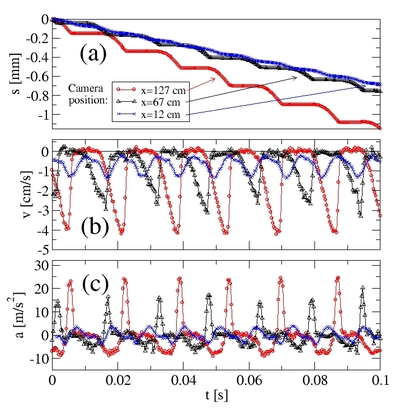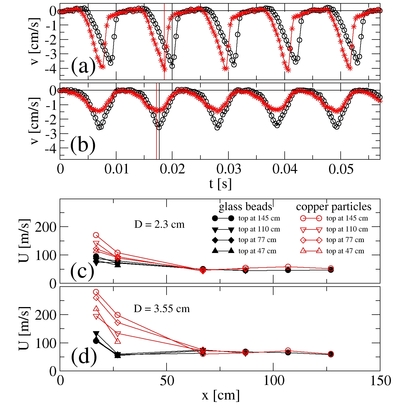|
We
report experimental observations
of sound waves in a granular material
during resonant silo discharge called silo music. The grain
motion was
tracked by high speed imaging while the resonance of the silo was
detected by accelerometers and acoustic methods as it is shown on the
scketch (a). Here we demonstrate the phenomenon using two
materials: spherical glass beads (b) and nearly spherical copper
particles (c).
 A sample movie recorded near the top of the tube shows the periodic grain motion during resonance (see right hand side of this page). |
 |
|
Measuring grain motion with high speed imaging
The movie corresponds to a
region with height of 1 cm. The averaged grain motion in this region is
shown in the next plots: (a) shows the position s of the particles as a function of
time, while (b) and (c) show the corresponding velocity v and acceleration a.
 The three measurements correspond to x=12 cm, x=67 cm and x=127 cm measured from the bottom of the tube. As it is seen, the grains move downwards with oscillating velocity. At the top and middle of the tube during each period the grains come to a full stop, remain standing for a considerable portion of the period and then accelerate downwards. Their acceleration almost reaches the value corresponding to free fall (g=-9.81 m/s2) near the top of the tube, but is lower in the middle of the tube. At the bottom of the tube one can still see oscillations in the grain velocity but the grains do not come to a full stop and their acceleration does not come close to g. Thus, grain oscillations show a stick-slip character only in the upper part of the silo. |
The
grains do not oscillate in phase at neighboring vertical locations (at
distance 10 cm), but there is a phase lag
(see
next figure a-b): information propagates upward in this
system in
the form of
sound waves. The wave velocity U
is not constant throughout the silo (see c-d), but considerably
increases toward the lower end of the system, suggesting increased
pressure in this region, where the flow changes from cylindrical to
converging flow.
 This underlines the importance
of the transition zone in the lower end of the silo, where the flow
changes from cylindrical to converging flow and is in accordance with
those observations which suggest that the source of the resonance
phenomenon is the generation of strong stress oscillations in this
region. As shown, the amplitude of the grain oscillations increases
with height and leads to stick-slip motion in the upper part of the
silo. This supports the
argument that appropriate friction with the walls is crucial for the
amplification of the waves and could be a necessity for strong
resonance as argued by other authors, which is also supported by the
fact that increasing the roughness of the silo walls (i.e. suppressing
stick-slip) effectively reduces the resonance.
|
|
|